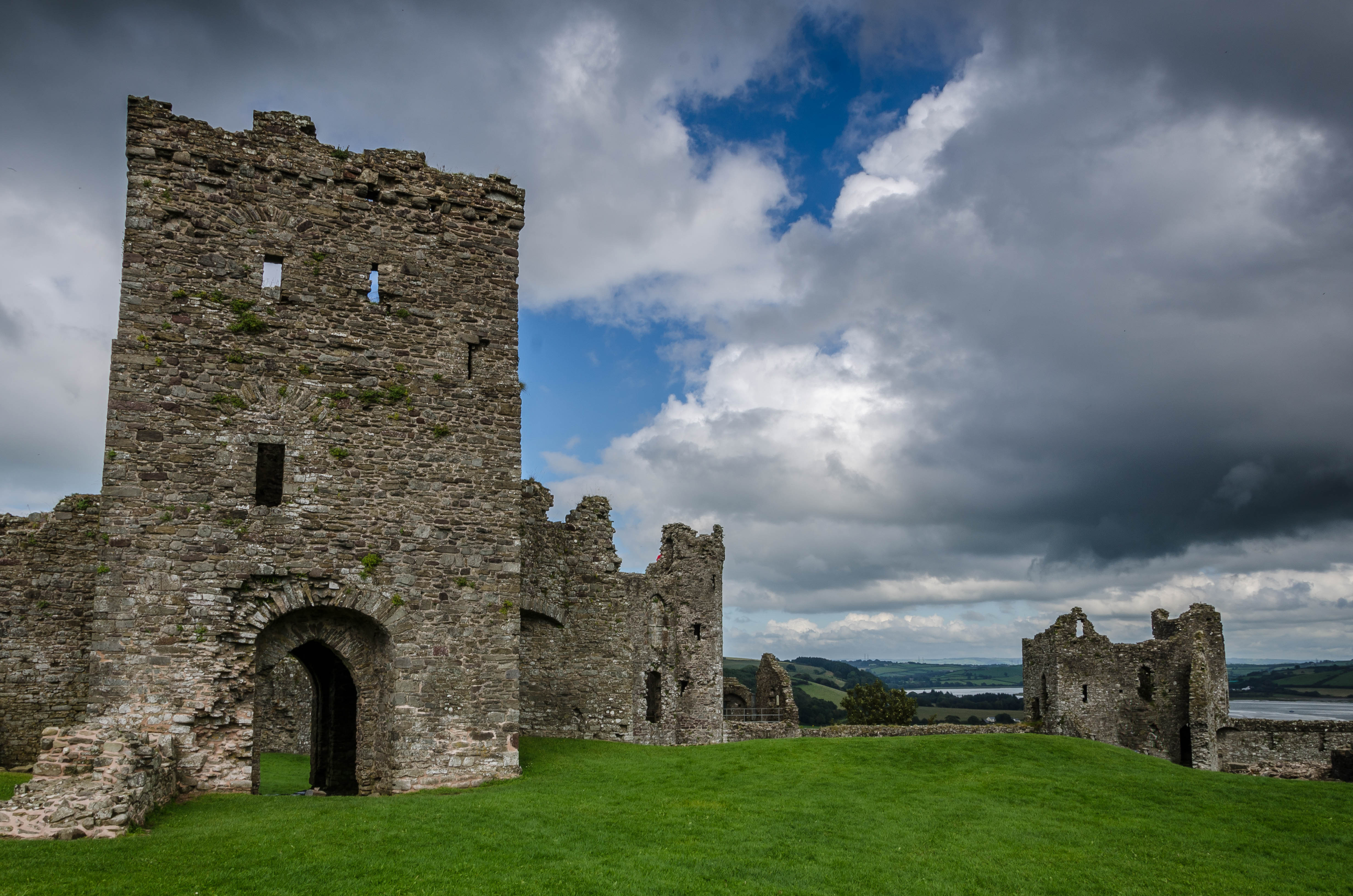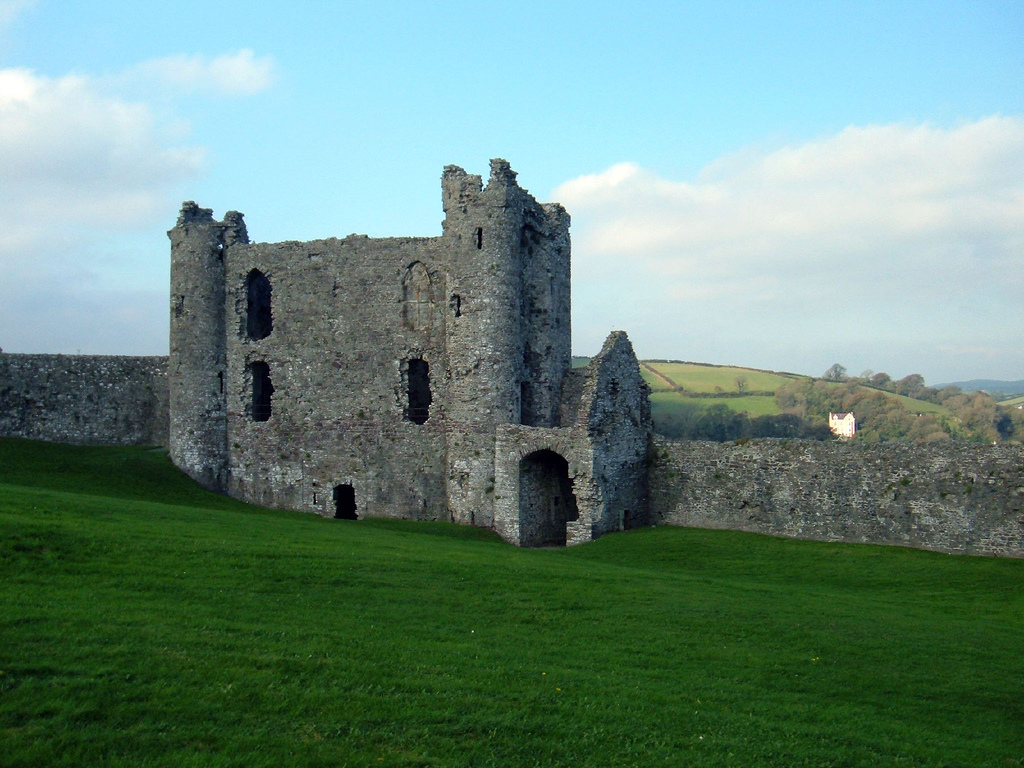Llansteffan Castle on:
[Wikipedia]
[Google]
[Amazon]
Llansteffan Castle ( cy, Castell Llansteffan) is a privately owned castle in Llansteffan, 


Carmarthenshire
Carmarthenshire ( cy, Sir Gaerfyrddin; or informally ') is a county in the south-west of Wales. The three largest towns are Llanelli, Carmarthen and Ammanford. Carmarthen is the county town and administrative centre. The county is known as ...
, Wales
Wales ( cy, Cymru ) is a country that is part of the United Kingdom. It is bordered by England to the east, the Irish Sea to the north and west, the Celtic Sea to the south west and the Bristol Channel to the south. It had a population in ...
, overlooking the River Tywi
The River Towy ( cy, Afon Tywi, ) is one of the longest rivers flowing entirely within Wales. Its total length is . It is noted for its sea trout and salmon fishing.
Route
The Towy rises within of the source of the River Teifi on the lower slo ...
estuary
An estuary is a partially enclosed coastal body of brackish water with one or more rivers or streams flowing into it, and with a free connection to the open sea. Estuaries form a transition zone between river environments and maritime environm ...
in Carmarthen Bay
Carmarthen Bay ( cy, Bae Caerfyrddin) is an inlet of the South Wales coast, including notable beaches such as Pendine Sands and Cefn Sidan sands. Carmarthen Bay is partially within the Pembrokeshire Coast National Park. The Joint Nature Conserva ...
.



Iron Age
The castle sits on a much olderIron Age
The Iron Age is the final epoch of the three-age division of the prehistory and protohistory of humanity. It was preceded by the Stone Age ( Paleolithic, Mesolithic, Neolithic) and the Bronze Age ( Chalcolithic). The concept has been mostl ...
promontory fort, proving Llansteffan has been inhabited for several millennia. The hill where the castle stands commands the River Tywi
The River Towy ( cy, Afon Tywi, ) is one of the longest rivers flowing entirely within Wales. Its total length is . It is noted for its sea trout and salmon fishing.
Route
The Towy rises within of the source of the River Teifi on the lower slo ...
estuary. The hill would have been stripped of trees so that foot soldiers were vulnerable to attack by archers. The original earthworks can still be seen and were used as part of the modern castle's defence system—the castle proper rests within the earthwork rings.
Conquest of West Wales
The castle was built by theNormans
The Normans ( Norman: ''Normaunds''; french: Normands; la, Nortmanni/Normanni) were a population arising in the medieval Duchy of Normandy from the intermingling between Norse Viking settlers and indigenous West Franks and Gallo-Romans. ...
after 1100 as part of their invasion of Wales and granted to the Marmion family before passing to the Camvilles through marriage.
It was captured by Maredudd ap Gruffydd
Maredudd ap Gruffydd (1131–1155) was a prince of the kingdom of Deheubarth in Southwest Wales.
Maredudd was the fifth of six sons of Gruffydd ap Rhys, and the third of four by Gwenllian ferch Gruffydd;Cadw, Welsh Government (Crown Copyright), ...
in 1146 against the forces of Maurice FitzGerald, Lord of Lanstephan
Maurice FitzGerald, Lord of Maynooth, Naas, and Llanstephan (born: almost certainly not at Windsor Castle, more likely Carew in Wales c.1105 – September c.1176 Wexford, Ireland. He was a medieval Anglo-Norman baron and a major figure in the N ...
and his brother William FitzGerald, Lord of Emlyn who were the leading Norman settlers of the region. The castle was retaken by the Normans in 1158. Llywelyn the Great recaptured the castle for the Welsh in 1215 and taken back by the Camville family sometime after 1223. The castle fell to Llywelyn ap Gruffudd
Llywelyn ap Gruffudd (c. 1223 – 11 December 1282), sometimes written as Llywelyn ap Gruffydd, also known as Llywelyn the Last ( cy, Llywelyn Ein Llyw Olaf, lit=Llywelyn, Our Last Leader), was the native Prince of Wales ( la, Princeps Wall ...
in 1257 but returned to the Camvilles by the 1260s.
By 1367, it was described as in a poor state.
Owain Glyndŵr
The castle was captured twice by the forces of Owain Glyndŵr in 1403 and c.1405. It was recaptured by Sir John Pennes in 1408. The castle was later granted to theCrown
A crown is a traditional form of head adornment, or hat, worn by monarchs as a symbol of their power and dignity. A crown is often, by extension, a symbol of the monarch's government or items endorsed by it. The word itself is used, partic ...
and the two-tower Gatehouse was converted into a residence.
Preservation
The castle, which is privately owned, is under a deed of guardianship with Cadw.See also
*List of hillforts in Wales
This is a list of hillforts in Wales.
Anglesey
* Din Sylwy (Bwrdd Arthur) (), contour fort
* Caer Idris Hillfort (), promontory fort
* Caer y Twr (), partial contour fort
* Dinas Gynfor (), promontory fort
* Dinas Porth Ruffydd (), promontory ...
References